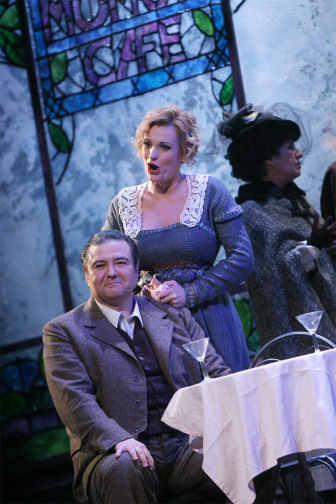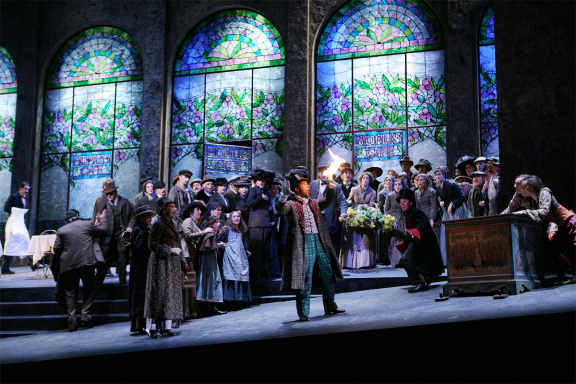Other Links
Editorial Board
-
Editor - Bill Kenny
-
Deputy Editor - Bob Briggs
Founder - Len Mullenger
Google Site Search
SEEN AND HEARD
INTERNATIONAL OPERA REVIEW
Puccini,
La Bohème:
Soloists, Orquesta Sinfónica de Navarra. Orfeón Pamplonés.
Conductor: Miguel Gómez Martínez. Auditorio El Baluarte
de Pamplona. 4. 3.2009. (JMI)
The musical direction was the responsibility of Miguel Angel Gómez
Martinez who replaced (during the rehearsal phase) Friedrich Haider
who, surprisingly, cancelled due to family problems. In these
circumstances to be able of assuring the presence of the
Granada-born maestro is an genuine achievement. Considering the
circumstances, Mr Gómez Martínez gave us a real musical miracle. Not
only did he conduct a most satisfactory Bohème, but he was
also able to help the singers and drew
what is probably the best performance I have heard from the Orquesta
Sinfonica de Navarra in any opera. To achieve all that in such a
short period of time is worthy of praise.
Director: José Luis Castro
Sets: Giuliano Spinelli
Costumes: Irene Monti
Lighting: Vinicio Cheli
Cast:
Mimí:
Ainhoa Arteta
Rodolfo: José Luis Duval
Marcello: Vladimir Chernov
Musetta: Sabina Puértolas.
Colline: Miguel Ángel Zapater
Schaunard: Juan Tomás Martínez
Alcindoro/Benoît: Lluis Sintes

This production of
La Bohème
was originally a collaboration between Santander and Córdoba, having
been premiered in November 2005. The stage direction was the
responsibility of Jose Luis Castro, former general director of
Seville’s Teatro de la Maestranza, who gave a traditional
interpretation of Puccini’s masterpiece. He transfers the action to
the 1920s and offers some attractive sets, suitable costumes, and
the usual good lighting work by Vinicio
Chelil. The production leaves ample space on the stage, especially
in Act II, avoiding the crowding which is so usual in other
productions. Jose Luis Castro simply relates the story of the young
bohemians (not so young in this case) without new readings or
attempts at originality. The only “exotic” point – which is not
convincing - consists of showing Rodolfo and Mimí singing their duet
“O soave fanciulla” out on the roof of the attic, reminiscent of a
scene from Mary Poppins!

As I have said, the biggest attraction of this Bohème was the
presence of Ainhoa Arteta as Mimí. Although the soprano from
Guipuzcoan is one of the best known Musettas in great opera houses,
this is not the first time she has sung Mimí. Very early in her
career (1992) she sang the role at Bilbao’s
Teatro Arriga opposite the American Richard Leech and a very young
Carlos Álvarez. In the past 17 years Ms Arteta Ainhoa's
voice has developed very positively and today she is in
enviable vocal shape. If in 1992 she was too light for Mimí,
she is now perfectly suited to the vocal demands of the
embroidery girl. This Mimí was
always bright, although at some moments she was rather short of
emotion, and this is a very important aspect of the character. I
believe that, once Ainhoa Arteta matures dramatically, she can be a
great Mimí. She has the voice, and has a shining and spectacular
way of projecting it. In the third act (Donde lieta usci) and
particularly in Act IV, she was Mimi, able truly to
move the audience as it should be
done, with all the fragility and
vulnerability of the role.
Mexican tenor Jose Luis Duval was a somewhat superficial interpreter
of Rodolfo. He is a tenor with a shining and powerful high register,
whereas the rest of the tessitura does not have the same quality,
and is reminiscent of certain 'old
fashioned' tenors. He is not too refined
or expressive as a singer either. You can
admire the top end of his voice, but treal
emotion is hardly ever present.
At almost 55, the Russian baritone
Vladimir Chernov preserves a warm timbre and great stage
presence. Many readers will remember him as the Verdi
baritone at New York Metropolitan in the 90s, although to my taste
he never was a dramatic baritone. Then and now he continues to be
an interesting singer, and although with time his projection has
not improved, he retains a fresh voice, although on stage he is not
too credible as the young painter Marcello.
The Navarra born soprano Sabina Puértolas was a reasonable Musetta,
although she was not too bright in vocal terms. Her voice is not big
and is rather tight at the top. In her favour I should mention that
she finished the famous Waltz in piano, as it always should.
The Asturian Miguel Zapater Angel was a somewhat coarse Colline,
short of nobility in “Vecchia Zimarra.” Venezuelan Juan Tomás
Martinez completed the Bohemian quartet as Schaunard.
The house was sold out. At the final bows Ainhoa Arteta received a
triumphant reception and Gómez Martinez,
Chernov and Puértolas were very warmly applauded.
José M Irurzun
Pictures - courtesy of
Auditorio El Baluarte de Pamplona
Back
to Top
Cumulative Index Page
